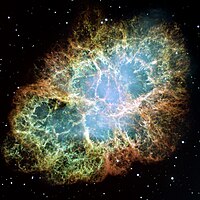
The influence of host galaxy morphology on the properties of Type Ia supernovae from the JLA compilation
Sign Up to like & getrecommendations! Published in 2017 at "New Astronomy"
DOI: 10.1016/j.newast.2016.08.009
Abstract: Abstract The observational cosmology with distant Type Ia supernovae (SNe) as standard candles claims that the Universe is in accelerated expansion, caused by a large fraction of dark energy. In this paper we investigate the… read more here.
Keywords: jla compilation; type supernovae; morphology; host ... See more keywords

The delay of shock breakout due to circumstellar material evident in most type II supernovae
Sign Up to like & getrecommendations! Published in 2018 at "Nature Astronomy"
DOI: 10.1038/s41550-018-0563-4
Abstract: Type II supernovae (SNe II) originate from the explosion of hydrogen-rich supergiant massive stars. Their first electromagnetic signature is the shock breakout (SBO), a short-lived phenomenon that can last for hours to days depending on… read more here.
Keywords: type supernovae; shock breakout; circumstellar material; shock ... See more keywords

The formation of solar-neighbourhood stars in two generations separated by 5 billion years
Sign Up to like & getrecommendations! Published in 2018 at "Nature"
DOI: 10.1038/s41586-018-0329-2
Abstract: The chemical compositions of stars encode those of the gas from which they formed, providing important clues regarding the formation histories of galaxies. A powerful diagnostic is the abundance of α elements (O, Mg, Si,… read more here.
Keywords: interstellar medium; type supernovae; gas; formation ... See more keywords

Progenitor properties of type II supernovae: fitting to hydrodynamical models using Markov chain Monte Carlo methods
Sign Up to like & getrecommendations! Published in 2020 at "Astronomy and Astrophysics"
DOI: 10.1051/0004-6361/202038393
Abstract: The progenitor and explosion properties of type II supernovae (SNe II) are fundamental to understand the evolution of massive stars. Special interest has been given to the range of initial masses of their progenitors, but… read more here.
Keywords: type supernovae; hydrodynamical models; mass; properties type ... See more keywords

Berkeley supernova Ia program: data release of 637 spectra from 247 Type Ia supernovae
Sign Up to like & getrecommendations! Published in 2020 at "Monthly Notices of the Royal Astronomical Society"
DOI: 10.1093/mnras/staa102
Abstract: We present 637 low-redshift optical spectra collected by the Berkeley Supernova Ia Program (BSNIP) between 2009 and 2018, almost entirely with the Kast double spectrograph on the Shane 3~m telescope at Lick Observatory. We describe… read more here.
Keywords: type supernovae; supernova program; berkeley supernova;

Early light curves of Type II supernovae interacting with a circumstellar disc
Sign Up to like & getrecommendations! Published in 2020 at "Monthly Notices of the Royal Astronomical Society"
DOI: 10.1093/mnras/staa2360
Abstract: Type II supernovae (SNe) interacting with disklike circumstellar matter (CSM) have been suggested as an explanation of some unusual Type II SNe, e.g., the so-called "impossible" SN, iPTF14hls. There are some radiation hydrodynamics simulations for… read more here.
Keywords: light curves; type supernovae; csm disk; sne ... See more keywords

A common-envelope wind model for Type Ia supernovae – I. Binary evolution and birth rate
Sign Up to like & getrecommendations! Published in 2017 at "Monthly Notices of the Royal Astronomical Society"
DOI: 10.1093/mnras/stx1137
Abstract: The single-degenerate (SD) model is one of the principal models for the progenitors of type Ia supernovae (SNe Ia), but some of the predictions in the most widely studied version of the SD model, i.e.… read more here.
Keywords: common envelope; cew model; type supernovae; otw model ... See more keywords

The evolution of temperature and bolometric luminosity in Type II supernovae
Sign Up to like & getrecommendations! Published in 2018 at "Monthly Notices of the Royal Astronomical Society"
DOI: 10.1093/mnras/stx2288
Abstract: In this work we present a uniform analysis of the temperature evolution and bolometric luminosity of a sample of 29 type-II supernovae (SNe), by fitting a black body model to their multi-band photometry. Our sample… read more here.
Keywords: temperature; evolution; bolometric luminosity; type supernovae ... See more keywords

Estimating dust distances to Type Ia supernovae from colour excess time evolution
Sign Up to like & getrecommendations! Published in 2017 at "Monthly Notices of the Royal Astronomical Society"
DOI: 10.1093/mnras/stx2291
Abstract: We present a new technique to infer dust locations towards reddened Type Ia supernovae and to help discriminate between an interstellar and a circumstellar origin for the observed extinction. Using ... read more here.
Keywords: dust distances; distances type; type supernovae; estimating dust ... See more keywords

The double-degenerate model for the progenitors of Type Ia supernovae
Sign Up to like & getrecommendations! Published in 2018 at "Monthly Notices of the Royal Astronomical Society"
DOI: 10.1093/mnras/stx2756
Abstract: The double-degenerate (DD) model, involving the merging of massive double carbon-oxygen white dwarfs (CO WDs) driven by gravitational wave radiation, is one of the classical pathways for the formation of Type Ia supernovae (SNe Ia).… read more here.
Keywords: degenerate model; type supernovae; double degenerate; subgiant channel ... See more keywords

Type II supernovae in low-luminosity host galaxies
Sign Up to like & getrecommendations! Published in 2018 at "Monthly Notices of the Royal Astronomical Society"
DOI: 10.1093/mnras/sty1581
Abstract: We present an analysis of a new sample of type II core-collapse supernovae (SNe II) occurring within low-luminosity galaxies, comparing these with a sample of events in brighter hosts. Our analysis is performed comparing SN… read more here.
Keywords: host galaxies; type supernovae; luminosity; host ... See more keywords